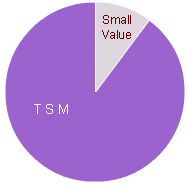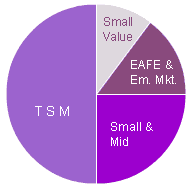Improved Portfolio Guidelines
Three pages ago we suggested an ultra-simple portfolio, of "mostly TSM plus some Small Value."
Now we're ready to refine that somewhat.
First, the reasoning process:
|

|
- A Total Stock Market index gives you maximum diversification and tax-efficiency, so it still makes sense as the core of a stock portfolio.
- The drawback of the TSM is that it puts so much of your money into the stocks of a few of the largest companies.
You can address this if you wish by adding small and mid caps, using individual indexes or combined indexes like the Wilshire 4500 or S&P Completion index.
- History shows that Small Value has beaten the rest of the market; but a Small Value index isn't very diversified or tax-efficient.
So it still makes sense to have "some" Small Value (as opposed to "a lot") and to keep it in a tax-sheltered account.
- Foreign stocks have their own advantages and problems; it makes sense to have "some" foreign stocks in your portfolio.
 If you agree with the reasoning in those four points then you get the allocation strategy illustrated here:
mostly TSM (but de-emphasizing the very largest companies, and including some of the global market), plus some Small Value.
If you agree with the reasoning in those four points then you get the allocation strategy illustrated here:
mostly TSM (but de-emphasizing the very largest companies, and including some of the global market), plus some Small Value.
|